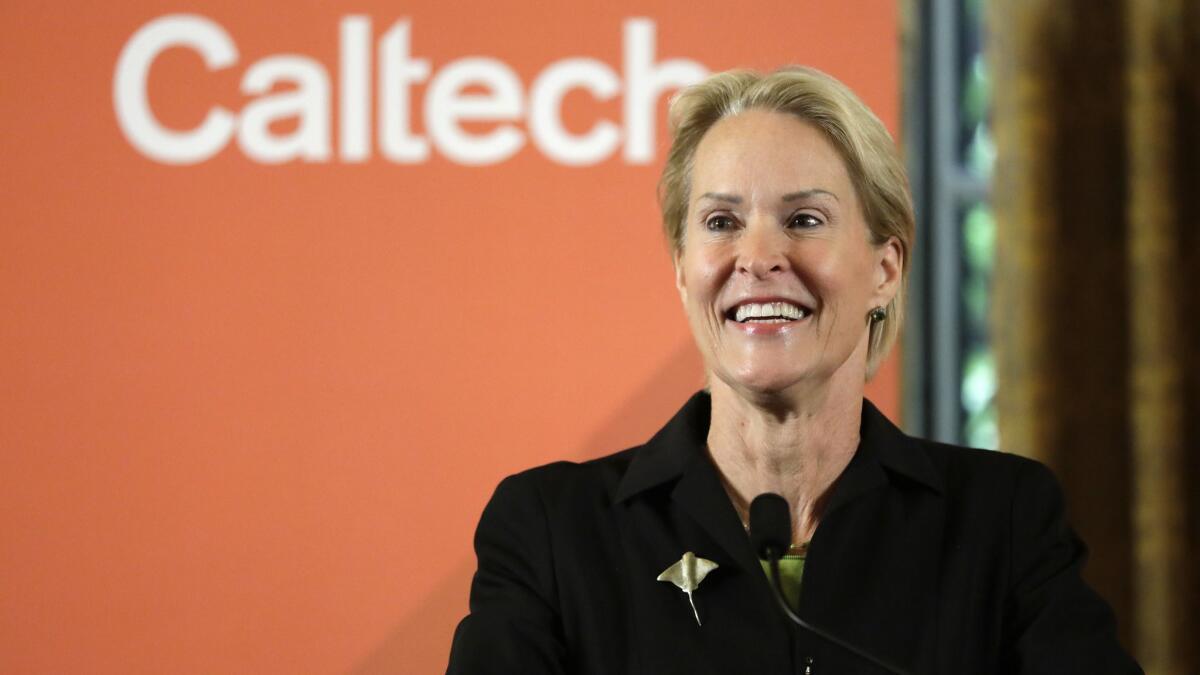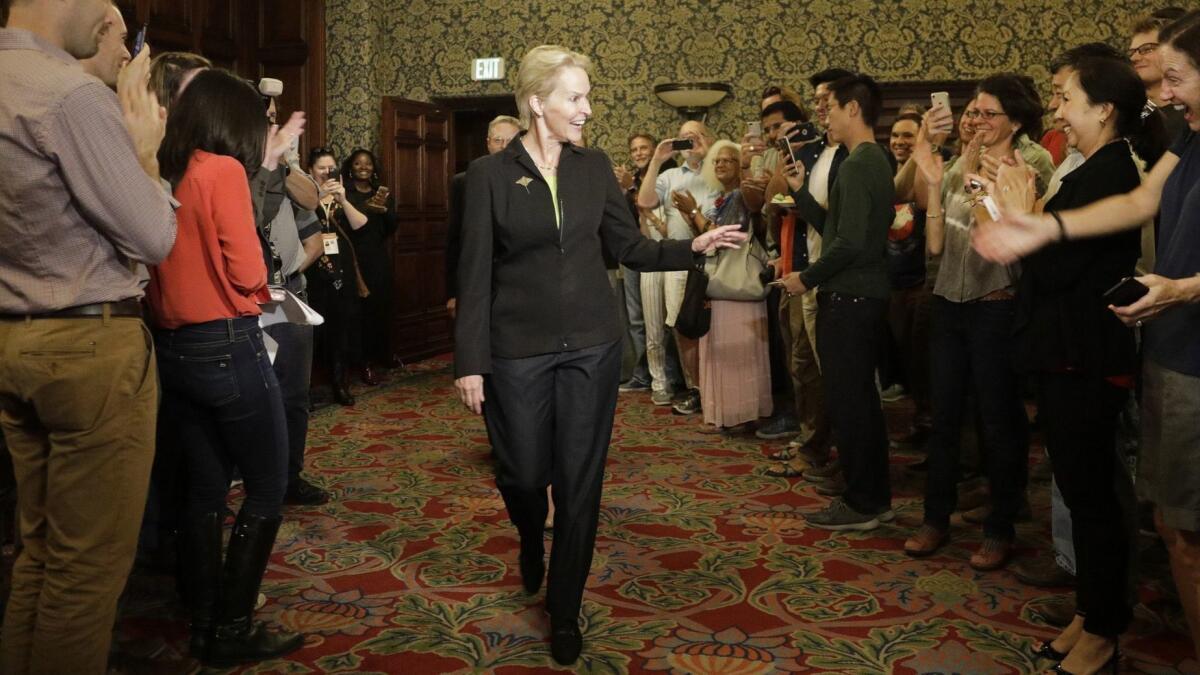Caltech scientist is among 3 awarded Nobel Prize in chemistry for sparking ‘a revolution in evolution’

For 3.7 billion years, nature has used the power of evolution to shape every living thing on Earth, creating a vast diversity of molecules with an ever-increasing array of abilities.
Three scientists who harnessed that power — and sped it up in the lab — were honored Wednesday with the Nobel Prize in chemistry. Their research has led to brand new chemical reactions that are used to make alternative fuels, agricultural chemicals, cancer medicines and more.
Frances Arnold, a biochemical engineer at Caltech, was awarded half of the $1.01-million prize for her pioneering experiments in the field known as directed evolution.
The other half of the prize was split between George P. Smith of the University of Missouri in Columbia and Gregory P. Winter of the MRC Laboratory of Molecular Biology in Cambridge, England, who paved the way for directed evolution to become an important tool in drug development.
Claes Gustafsson, chairman of the Nobel committee that selected the winners, said the three sparked “a revolution in evolution.”
“Our laureates have applied the principles of Darwin in the test tube and used this approach to develop new types of chemicals for the great benefit of humankind,” he said.
Arnold said the phone call from Stockholm had her “bouncing off the walls.” But it came with a measure of annoyance because she was traveling in Texas and couldn’t rouse her family in California to share the news.
“They never answer the phone when Mom calls,” she said.

Arnold is the fifth woman to win a Nobel Prize in chemistry and the first since 2009, when Ada Yonath of the Weizmann Institute of Science in Israel was honored for her work in mapping the structure of ribosomes.
Marie Curie became the first woman to win the chemistry prize in 1911, for her discovery of the radioactive elements radium and polonium. She had already won the Nobel Prize in physics eight years earlier.
Arnold is the first woman at Caltech to receive a Nobel Prize. But she does not expect to be the last.
“There are a lot of brilliant women in chemistry,” she said. “I predict we are going to see a steady stream of Nobel Prizes in chemistry given to women in the future.”

Initially trained as a mechanical and aerospace engineer, Arnold would discover that she could improve the world through chemistry. She hoped to replace traditional chemical reactions that used heavy metals, solvents and destructive acids with new reactions inspired by the inner workings of living beings.
The key to her plan was enzymes, the proteins that direct biochemical reactions inside organisms. To get a desired reaction, she needed to customize an enzyme. But she came to realize that engineering an enzyme was way too big a job for humans, even with their state-of-the-art computers.
But the job wasn’t too big for nature.
“I think of what I do as copying nature’s design process,” she said.
In directed evolution experiments, scientists start with an enzyme that has some of the properties they are looking for. Next, they introduce a few mutations into its genetic code — perhaps by inserting a sequence from another enzyme with different desirable properties. Then they allow the enzyme to replicate, usually inside bacteria.
At this point, nature takes its course, and new, random mutations develop through the same process that drives evolution.
Scientists then screen all the resulting enzymes, selecting the ones that do the best job of carrying out the hoped-for reaction. The other enzymes are discarded, and the process is repeated over and over until the desired result is reached.
By relying on random genetic mutations to create many different versions of a single enzyme, a scientist doesn’t have to know ahead of time which specific mutation will create the desired result.
“It was an important conceptual approach,” said Harvey Blanch, a professor of biochemical engineering at UC Berkeley who was Arnold’s thesis advisor there. “By doing what nature does, you can get the job done much more quickly.”
Arnold’s colleague Dave Tirrell, a professor of chemistry and chemical engineering at Caltech, put it this way: “She taught enzymes to do things no self-respecting enzyme would do.”

Arnold was not the first person to ever conceive of directed evolution, but she was the first to show that it works and has developed the idea more fully than anyone else, Tirrell said.
Her work has been used to create biofuels, make more effective pharmaceuticals and even create more environmentally friendly detergents.
In 2016, her lab created enzymes that can form silicon-carbon bonds, a chemical reaction that doesn’t exist in nature.
The work could open the door to new kinds of organic chemistry and drug development. Scientists are also hopeful that it can help them investigate essential mysteries, such as whether extraterrestrial life could be based on silicon instead of carbon.
“I think we are just at the start of what’s possible with directed evolution,” said Sara Snogerup Linse, a member of the Nobel Committee for Chemistry.
Smith and Winter used a different approach that was geared to other kinds of proteins.
Smith’s idea was to get bacteriophages to do some of the work for him. Bacteriophages, or simply phages, are viruses that infect bacteria. Their DNA is on the inside, and the proteins it codes for appear on the outside.
Smith took advantage of this situation by inserting gene fragments into a phage, then checking to see which proteins appeared. In essence, he got the phage to identify useful pieces of DNA.
Winter embraced this technique — which came to be known as “phage display” — and used it to create antibodies that could function as drugs.
Antibodies are proteins that attach themselves to viruses, bacteria and other foreign substances so that the body’s immune system can target them for destruction. Winter set out to engineer antibodies that could attach to other targets the body should destroy, like cancer cells.
With directed evolution, Winter created many generations of antibodies, each time introducing new mutations and then selecting the ones that did the best job of attaching to its intended target.
This is how Winter and his colleagues created the antibody adalimumab, better known as the rheumatoid arthritis drug Humira. It binds to a protein that normally causes inflammation, neutralizing it in the process.
Other antibody drugs developed through this technique have been approved as treatments for lupus, cancer and the toxin that causes anthrax. An antibody designed to fight Alzheimer’s disease is now being tested in clinical trials.
This is second year in a row Caltech faculty have won a Nobel Prize. Kip Thorne and Barry Barish shared the physics prize in 2017 for making it possible to detect gravitational waves, confirming key aspects of Einstein’s general theory of relativity.
Altogether, 39 Caltech faculty and alumni have received Nobels, according to the university.
Read more:
Inspired by evolution: Caltech bioengineer is first woman to win $1.1-million tech prize
Scientists design living organisms that make chemical bonds not found in nature
MORE IN SCIENCE
UPDATES:
5:10 p.m.: This story has been updated throughout with additional detail and comments from Dave Tirrell of Caltech.
10:50 a.m.: This story has been updated with comments from Harvey Blanch of UC Berkeley.
10:10 a.m.: This story has been updated throughout with staff reporting.
This story was originally published at 3:25 a.m.








